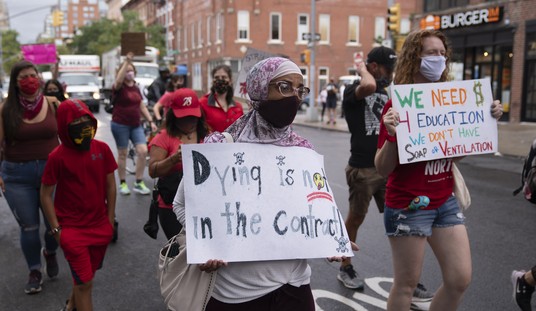UPDATE: Officer Slager has been fired. North Charleston Police Chief, Eddie Driggers, said he was "sickened" by the video. The North Charleston mayor announced that every officer will soon be wearing body cams (via AP):
A white South Carolina police officer who claimed he killed an unarmed black man in self-defense has been fired, the city's mayor announced Wednesday, a day after the release of a video showing the officer firing eight shots at the fleeing man's back.
The mayor also announced that he had ordered body cameras to be worn by every single officer on the force in North Charleston.
Protests began within hours of the murder charge against Michael Thomas Slager.
"I have watched the video. And I was sickened by what I saw. And I have not watched it since," Police Chief Eddie Driggers said. He was interrupted by chants of "no justice, no peace" and other shouted questions that he and the mayor said they could not answer.
The town will continue to pay for Slager's health insurance because his wife is eight months pregnant, said Mayor Keith Summey, who called the incident a tragedy for two families.
**Original Post**
A police officer from North Charleston, S.C. has been charged with murder after a video showed him shooting a man in the back eight times. The officer being charged, Michael T. Slager, said that he shot and killed Walter L. Scott out of fear for his life after Scott allegedly grabbed his stun gun in a brawl following a traffic stop. However, the video shows Scott running from Officer Slager, who proceeded to shoot and kill him (via NYT):
Recommended
The shooting unfolded after Officer Slager stopped the driver of a Mercedes-Benz with a broken taillight, according to police reports. Mr. Scott ran away, and Officer Slager chased him into a grassy lot that abuts a muffler shop. He fired his Taser, an electronic stun gun, but it did not stop Mr. Scott, according to police reports.Moments after the struggle, Officer Slager reported on his radio: “Shots fired and the subject is down. He took my Taser,” according to police reports.
But the video, which was taken by a bystander and provided to The New York Times by the Scott family’s lawyer, presents a different account. The video begins in the vacant lot, apparently moments after Officer Slager fired his Taser. Wires, which carry the electrical current from the stun gun, appear to be extending from Mr. Scott’s body as the two men tussle and Mr. Scott turns to run.
Something — it is not clear whether it is the stun gun — is either tossed or knocked to the ground behind the two men, and Officer Slager draws his gun, the video shows. When the officer fires, Mr. Scott appears to be 15 to 20 feet away and fleeing. He falls after the last of eight shots.
The officer then runs back toward where the initial scuffle occurred and picks something up off the ground. Moments later, he drops an object near Mr. Scott’s body, the video shows.
The South Carolina Law Enforcement Division, the state’s criminal investigative body, has begun an inquiry into the shooting. The F.B.I. and the Justice Department, which has opened a string of civil rights investigations into police departments under Mr. Holder, is also investigating.
…
Mr. Scott had been arrested about 10 times, mostly for failing to pay child support or show up for court hearings, according to The Post and Courier newspaper of Charleston. He was arrested in 1987 on an assault and battery charge and convicted in 1991 of possession of a bludgeon, the newspaper reported. Mr. Scott’s brother, Anthony, said he believed Mr. Scott had fled from the police on Saturday because he owed child support.
The use of deadly force by police was a subject resurrected last summer when then-Officer Darren Wilson shot and killed Michael Brown in self-defense in Ferguson, Missouri. While Brown wasn’t shot in the back, it did stir some debate about Missouri’s use of deadly force laws on behalf of law enforcement; some thought it was very lax.
In Tennessee v. Garner, the Burger Supreme Court ruled in the 1985 that police officers could shoot a fleeing suspect in limited circumstances.
From Justice Byron White’s opinion, the case revolved around two Memphis police officers, Elton Hymon and Leslie Wright, responded to a burglary call at 10:45pm on October 3, 1974. Upon entering the house in question, the encountered 15-year-old Edward Garner, who officers thought was 17 or 18, who fled the scene. Officer Hymon couldn’t tell for certain, but was “reasonably sure” that Garner was unarmed when he saw him using his flashlight.
While Garner tried to climb over a fence, the Officer Hymon identified himself as law enforcement and told him to “halt.” Garner did not heed the call. Hymon, convinced Garner “would elude capture,” fired a shot, hitting him in the back of the head. He later died. Garner’s father brought lawsuits before the court citing his son’s constitutional rights were violated. The Tennessee statue that Hymon invoked reads "[i]f, after notice of the intention to arrest the defendant, he either flee or forcibly resist, the officer may use all the necessary means to effect the arrest."
Justice White wrote:
The use of deadly force to prevent the escape of all felony suspects, whatever the circumstances, is constitutionally unreasonable. It is not better that all felony suspects die than that they escape. Where the suspect poses no immediate threat to the officer and no threat to others, the harm resulting from failing to apprehend him does not justify the use of deadly force to do so. It is no doubt unfortunate when a suspect who is in sight escapes, but the fact that the police arrive a little late or are a little slower afoot does not always justify killing the suspect. A police officer may not seize an unarmed, nondangerous suspect by shooting him dead. The Tennessee statute is unconstitutional insofar as it authorizes the use of deadly force against such fleeing suspects.It is not, however, unconstitutional on its face. Where the officer has probable cause to believe that the suspect poses a threat of serious physical harm, either to the officer or to others, it is not constitutionally unreasonable to prevent escape by using deadly force. Thus, if the suspect threatens the officer with a weapon or there is probable cause to believe that he has committed a crime involving the infliction or threatened infliction of serious physical harm, deadly force may be used if necessary to prevent escape, and if, where feasible, some warning has been given. As applied in such circumstances, the Tennessee statute would pass constitutional muster.
Nevertheless, in this circumstance, Mr. Scott had no weapon, and the assumption made by his brother that he was fleeing due to back payments on child support isn’t a crime that inflicts “serious physical harm.” At the same time, Jonathan Turley, a law professor at the George Washington University Law School, wrote on his blog that if it can be established that Scott tried to use Slager’s taser, then the Garner decision applies:
The question is likely to be whether the struggle and failed use of the taser created a sufficient basis for Slager to believe that he had probable cause that Scott was posed a serious threat to him or others. Slager could claim that, the fact that Scott allegedly attacked him and tried to take his taser, was enough to satisfy that Garner standard. This is the ultimate jury decision and the image of shooting a fleeing suspect in the back will obviously present a considerable challenge for the defense.
In this instance, the charge is appropriate, and this issue will be settled in a court of law, as it should.

























Join the conversation as a VIP Member